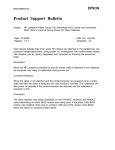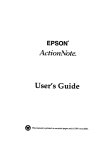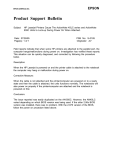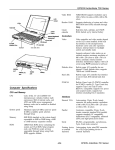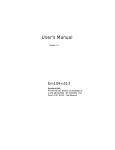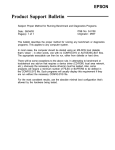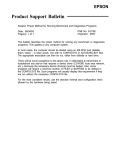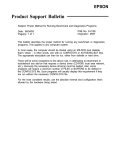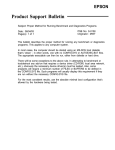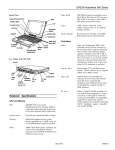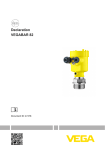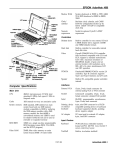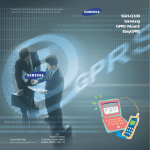Download Epson ActionNote 4SLC/25 Product Support Bulletin
Transcript
EPSON AMERICA. INC. EPSON Product Support Bulletin Subject: HP Laserjet Printers Cause The ActionNote 4SLC series and ActionNote 500C Units to Lock-up During Power On When Attached. Date: 07/26/95 Page(s): 1 of 1 PSB No: S-0185 Originator: AV Field reports indicate that when some HP printers are attached to the parallel port, the computer hangs/malfunctions during power on. Investigation has verified these reports. This situation can be quickly diagnosed, and corrected by following the procedure below. Description: When the HP Laserjet is powered on and the printer cable is attached to the notebook the computer may hang or malfunction during power on. Corrective Measure: When the cable is not attached and the printer/computer are powered on to a ready state and then the cable is attached, the units functions normally. The notebooks will also power on properly if the printer/computer are attached and the notebook is powered on first. Conclusion: The issue reported was easily duplicated on the AN-500C. However, the AN4SLC varied depending on which BIOS version was being used. If the older 2.06s BIOS version was installed, there was no problem. With the 2.07S version of the BIOS, follow the power on procedure listed above. EPSON AMERICA, NC. Product Support Bulletin Subject: Epson ActionNote 4SLC/25 Questions and Answers Date: 06/04/93 Page(s): 1 of 6 PSB No: S-0161 Originator: AV/KS Q1. What is the Epson ActionNote 4SLC/25? A1. The Epson ActionNote 4SLC/25 is Epson’s newest notebook computer. The ActionNote 4SLC/25 offers the full functionality of an AT-compatible computer, with excellent expansion capabilities. Q2. What are some of the standard features? A2. The Epson ActionNote 4SLC/25 includes a 25MHz 486SLC microprocessor; support for an optional 80387SX/SL or 387SLC numeric coprocessor; 4MB of RAM (2MB soldered on motherboard and 2MB memory card); 1 removable, rechargeable NiCad battery; a 3.5", 1.44MB floppy disk drive; 640 x 480, back-lit monochrome VGA-compatible LCD; parallel/external FDD port, two RS-232C serial ports and an RJ-11 port (when modem is installed, COM2 is disabled); an external VGA analog monitor port; connector for an external keyboard or mouse; Logitech Trackball; MS-DOS 5.0, Windows 3.1. and a carrying case. Q3. What are the options and expansion capabilities? A3. The 4MB of system RAM can be expanded to 8MB total by removing the existing 2MB memory module and installing an optional 6MB memory module. A 2400/9600 Fax/Modem option kit is available which contains the Bitcom and Winfax Lite software. In addition to the 6MB memory module and 2400/9600 Fax/Modem Kit, Epson will offer a spare NiCad battery pack, an Auto Adapter, and a "Y" external keyboard/ mouse adapter that will allow you to use a pointing device and keyboard simultaneously. Further upgrades include an Intel 80387SX or CX387SLC math coprocessor available to customers through their local dealer. PSB No: S-0161 Page: 2 of 6 Q4. How much does the Epson ActionNote 4SLC/25 weigh? A4. 5.5 pounds with the hard drive cartridge and battery installed. At 1.63” by 8.75" by 11”, the Epson ActionNote fits easily in a standard briefcase. Q5. What kind of battery life can you expect from the Epson ActionNote 4SLC/25? A5. Testing has revealed, under typical operating conditions, an estimated battery life of 1.5 to 2 hours. Depending on the configuration and usage, the battery life could be more or less. Q6. Are additional batteries available? How are the batteries charged? A6. Yes, additional batteries are available as an option. The batteries can be charged in the Epson ActionNote 4SLC/25 by connecting the standard AC adapter. The notebook should be turned off or in “suspend mode’ to charge the battery. Q7. Can batteries be changed “on the fly’? A7. No! The Epson ActionNote 4SLC/25 must be powered off before changing the battery. Attempting to change it while the computer is powered on will damage the battery or computer (possibly both) and void the warranty. Q8. How long does it take to fully charge the battery? A8. It takes 3.5 to 4 hours to fully charge the battery. Note that if you do not completely charge a new battery and attempt to use the computer, you may experience atypical operation. Q9. Are there any other power supply options? A9. Yes, an automotive cigarette lighter adapter will be available. Q10. How much do the batteries weigh? A10. Approximately 8 ounces each. PSB No: S-0161 Page: 3 of 6 Q11. What hard drives are being used? A11. The Toshiba MK1422MCV, 2.5” 86MB HDD and the Areal A120, 2.5” 136.9MB HDD. Q12. What floppy disk drive is used? A12. The Teac FD-05HF, 3.5” 1.44MB HDD. Q13. What external floppy drives can be used? A13. Pacific Rim and ValuStor external, 1.2MB FDDs have been found compatible. Q14. What type of LCD display is used? A14. The LCD is a large 10", 640 x 480 VGA backlit monochrome display with 7 1/2 - inch by 5 3/4- inch display area. VGA color is emulated with 32 shades of gray. Q15. Can you display on the external CRT port and LCD simultaneously and what are the maximum resolutions available ? A15. Yes, the computer should automatically recognize the external VGA monitor if it is attached before the ActionNote 4SLC/25 is turned on. You have the ability to control CRT/PANEL simulscan or the external CRT or internal LCD, individually, through a utility program called VGACONF.EXE. The maximum resolution for the built in LCD is 640 x 480 x 16 colors. The maximum resolution for the external CRT port is 800 x 600 x 16 colors. Q16. What video drivers are supplied with the computer? A16. The ActionNote 4SLC/25 Reference Diskette contains the following VGA drivers: Lotus 1-2-3, version 2.x 100x60text Microsoft Windows Ver. 3.0 640 x 480 by 16 colors 800 x 600 by 16 colors Word Perfect V5.1 800 x 600 by 16 colors Please note that the 800 x 600 drivers will not work on the internal LCD. Also the VGA configuration utility - VGACONF.EXE - is provided for LCD enhancements. PSB No: S-0161 Page: 4 of 6 Q17. How do you control normal versus reverse video display? A17. This is accomplished through VGACONF.EXE. There are four choices available. ETDG - Enable text and disable graphics reverse video NOREVERSE - disable text and graphics reverse video REVERSE - enable text and graphics reverse video DTEG - Disable text and enable graphics reverse video (Normal is black characters on a white background). Q18. What type of microprocessor does the ActionNote 4SLC/25 use? A18. The ActionNote 4SLC/25 comes with either a TI (Texas Instrument ) or Cyrix 486SLC/25 microprocessor. This processor is an advanced 32-bit, X86compatible processor offering high performance and integrated power management on a single chip. The 486SLC is 486SX instruction set compatible and 386SX bus compatible. It features a 1KB internal, two-way set associative cache. In the future, a 33MHz. version may be offered. Q19. Can I upgrade my ActionNote 4SLC/25 by using an Intel Overdrive Chip? A19. The Intel Overdrive Chip is not compatible with the Epson ActionNote 4SLC/25. Q20. What type of System BIOS is in the ActionNote 4SLC/25 and how do I run the SETUP program? A20. The SYSTEM and VGA BIOS conform to Seiko Epson BIOS specifications in a single 1024KB (OT) EPROM. It supports Shadow Ram. To run the SETUP program, you need to briefly press the delete key when the ActionNote 4SLC/25 is booting. While the ActionNote is counting the memory, you will see a message to hit the ‘delete” key to run setup. If you pressed the delete key, you will see the ‘BIOS Setup Program - AMI BIOS SETUP Utilities (C) 1990 American Megatrends Inc, All Rights reserved” screen. PSB No: S-0161 Page: 5 of 6 Q21. What Real Time Clock chip does the ActionNote 4SLC/25 use? A21. The Dallas RTC ( DS 1287 ) chip is soldered on the system board, which includes the Lithium backup battery. Q22. What software and documentation is included with the ActionNote 4SLC/25? A22. Currently we are offering MS-DOS Version 5.00, MS Windows Ver 3.1, the ActionNote User’s Guide, Quick Reference Guide, Reference Diskette, Logitech Trackman Trackball software and User’s Guide. If the unit was purchased with the optional internal modem, Winfax Lite and Bitcom software are included. NOTE: MS-DOS Version 6.0 will be included when available. Q23. What about power management software? A23. On the ActionNote Reference Diskette, under the Utils sub-directory you will find the file VGACONF.EXE. One of the selections available in VGACONF.EXE is the Standby Timer option. This feature sets the LCD power shutdown time when there is no keyboard or display activity. Whatever time is set by this option, will override any time set in the SETUP utility. Q24. Are there any special power saving features to help prolong battery life? A24. Yes. One way to help prolong battery life is to select the “Advanced Chipset Setup’ in the SETUP program and enable the Power Management Function and the other is to manually put the computer is “Suspend Mode”. The Power Management Utility in SETUP turns off the LCD and hard drive to reduce battery drain when the system is inactive and running off the rechargeable battery pack. The three devices you can select for the time of inactivity timeout are 1) the Display Timeout Counter; 2) Hard Disk Timeout Counter and 3) System Timeout Counter. This is in addition to the “display timeout option” discussed previously with VGACONF.EXE. PSB No: S-0161 Page: 6 of 6 Q25. How do you manually put the ActionNote 4SLC/25 in ‘suspend mode”? A25. This can be accomplished by sliding the ‘Suspend/Resume” button to the right or by closing the ActionNote 4SLC25 LCD. Q26. How do you “resume” the ActionNote 4SLC/25? A26. A keystroke should “wake-up” the ActionNote. Preferably, the spacebar should be used. Q27. What if the computer has entered the Standby timeout mode and a keystroke doesn’t bring it back to normal operating mode? A27. There are some applications that may intercept any keystrokes before they can be seen by the system BIOS. You may have to disable the timeout in SETUP (or VGACONF.EXE ) to use the problem application on battery power. Q28. Any other power saving tips? A28. One more - with the keyboard NUMLOCK on, use the keyboard command <Ctrl>-<Alt>-<+/-> [ on the embedded numeric keypad ] to change the CPU speed from 25MHz to 8MHz. This can save a significant amount of power and, with several types of applications (such as word processing), the system will not appear to be appreciably slower. Q29. How’s the software compatibility with the Epson ActionNote 4SLC/25? A29. Very good. Almost every type of software that’s been tried on the Epson ActionNote 4SLC/25 has worked as it should. You may need to experiment with the different display options for a given package - some will work fine as standard VGA, others will have a special option for an LCD display. You can also experiment with reversing the display mode and enabling contrast enhancements using the VGACONF.EXE utility found on the Reference Diskette. Q30. How well does the ActionNote 4SLC/25 work with local area networks? A30. Very well. Novell has certified the ActionNote 4SLC/25 as a workstation and in-house testing has been completed for several other networking environments as well. EPSON Product Support Bulletin Subject: Proper Method for Running Benchmark and Diagnostics Programs Date: 06/04/93 Page(s): 1 of 1 PSB No: S-0158 Originator: MWT This bulletin describes the proper method for running any benchmark or diagnostics programs. This applies to any computer system. In most cases, the computer should be started using an MS-DOS boot diskette that’s ‘clean’ - in other words, one with no CONFIG.SYS or AUTOEXEC.BAT files. The appropriate executable can then be run, either from diskette or hard drive. There will be some exceptions to the above rule. In attempting to benchmark or troubleshoot any add-on that requires a device driver (CD-ROM, local area network, etc.), obviously the necessary device driver(s) must be loaded. Also, some programs will require a minimum number of FILES or BUFFERS to be defined in the CONFIG.SYS file. Such programs will usually display this requirement if they are run without the necessary CONFIG.SYS file. For the most consistent results, use the absolute minimal boot configuration that’s allowed by the hardware being tested. PSB No.: S-0062I Page: 1 of 18 NBSL/20 VER 1.25 PART # DESC CMGO-A03 TYPE ROM LOC REASON INITIAL RELEASE (See TIB No: NBSL-002 For NB-SL FLASH BIOS version history. NBSL/25 VER 1.25 PART # DESC CMGO-A03 TYPE ROM LOC REASON INITIAL RELEASE (See TIB No: NBSL-002 For NB-SL FLASH BIOS version history. ACTIONNOTE 4SLC/25 VER 2.04S PART # 2011208 DESC AWARD TYPE PLCC LOC U12 REASON INITIAL RELEASE ACTIONNOTE 4SLC/33 VER 2.05S PART # 2011208 DESC AWARD TYPE PLCC LOC U12 REASON INITIAL RELEASE ACTIONNOTE 4000 VER 1.02S PART # DESC AWARD TYPE 27C010 LOC U30 REASON INITIAL RELEASE









